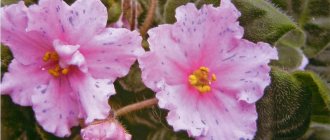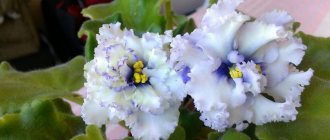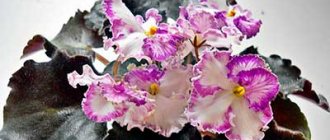Saintpaulia is a genus of beautiful flowering plants in the Gesneriaceae family. One of the most popular indoor flowers. There are a huge number of varieties of Saintpaulias, or, as they are called, “Usambara violets”. You can choose almost any variety with the desired size and color. Compact, bright plants that can bloom almost all year round. Let's take a closer look at what these indoor flowers are and how to care for them.
Do not confuse Saintpaulia with Viola. These are two different genera belonging to completely different families. Saintpaulia, also known as Usambara violet, belongs to the Gesneriaceae family and is a tropical plant. While the Violet, known to us under the common name “Pansy”, belongs to the Violet family and is grown as a garden plant.
Saintpaulia, or Usambara Violet © Burke County Center - NC State University
History of the discovery and spread of Saintpaulia
The Uzambara violet was discovered in 1892 by Baron Walter von Saint-Paul (1860-1940), commandant of the Uzambara district, a German colony located in the territory of modern Tanzania, Burundi and Rwanda. Walter Saint-Paul noticed this plant while walking. He sent the collected seeds to his father, the president of the German Dendrological Society, and he gave them to the botanist Hermann Wendland (1825-1903). Wendland grew the plant from seed and in 1893 described it as Saintpaulia ionanta, establishing the species as a separate genus, which he named after the Saint-Pauls father and son.
Saintpaulia was first presented at the international flower exhibition in Ghent in 1893. In 1927, Saintpaulias came to the United States, where they immediately gained popularity as indoor plants. By 1949, one hundred varieties had already been bred. Today the number of varieties exceeds 32 thousand, of which over 2 thousand are domestic.
Description of Saintpaulia
Saintpaulia is loved in indoor floriculture for its small size and long (up to 10 months a year) flowering. The flowerpot is usually a low herbaceous plant with fleshy, hairy, round leaves. Leaves of green or spotted color are located on shortened stems forming a basal rosette.
The flowers have five petals, collected in racemes. Color and shape depend on the variety. Saintpaulia also has a calyx consisting of five sepals. The fruit is a capsule with numerous small seeds with a straight embryo.
The natural range of Saintpaulia is limited to the mountainous regions of Tanzania and Kenya, with the vast majority of species found only in Tanzania, in the Ulugur and Usambara Mountains (usually the name "Usambara Mountains" on modern maps). Saintpaulias often grow near waterfalls, rivers, in conditions of spray and fog.
Classification of varieties of indoor violets
Today, the catalog of varieties of this plant amazes with its rich colors . Moreover, they are all relatively easy to grow. Another unique feature is the ability to grow in corridors and rooms without windows only due to artificial light.
For professionals, violets bloom for up to 10 months in a row . At home, with sufficient information, achieving several blooms per year will not be difficult. After studying the photos with the names of the varieties, you can choose the best specimens for yourself.
According to the diameter of the socket
- Miniature – from 6 to 15 cm (Davy Crockett, Midget Valentine).
- Semi-miniature (transitional look between mini and standard) – 15–20 cm (Dora Baker, Window Lace).
- Standard – 20 – 40 cm (Northern Lights, Ruffled Skies-2).
- Large – more than 40 cm (Sea wolf).
According to the shape of the flower
- Simple. The corolla consists of 5 petals. The top two are smaller in size than the bottom three. In the middle there are bright yellow pollen sacs (Dancing Flames).
- Stars. All petals are equal in size and located at the same distance (Rob`s Scrumptious, Saintpaulia Buckeye Seductress).
- Bells. This form is characteristic of miniature varieties. The flowers are symmetrical, reminiscent of the bell of a gramophone (Teeny Bopper).
- "Wasp". The rarest form of flower. The corolla lobes have deep dissections, and each individual petal does not touch the neighboring one (Senk`s Vespa Verde).
By degree of terry
- Non-double. The structure of a flower is similar to a simple one (Fancy Pants).
- Semi-double. More than 5 petals, but yellow anthers are still visible (Macho).
- Terry. Minimum 10 petals. The yellow eye is no longer noticeable (Candy Dandy, Fairy violet).
By variety of colors
- Carmine: Mark, Silver Milestone, Andrew Lan.
- Coral: Coral Crest, Fluted Coral.
- Sapphire and crimson: Wisteria, Blue Ice, Wonderland.
- White: Arctic Mist, Aca's Snowbird, White Kathleen.
- Pink: Classic Pink, Becky, Rapsodie Gisela.
Along the edge of the petal
- Smooth (Maria Mirabella).
- Wavy (Bullfight).
- Frilly (Yesenia).
- With fringe (Cinderella's Dream).
- Corrugated (Viscount).
Ampelous
They have one main stem, which branches into several leaf rosettes. Famous varieties: Breezy Blue, Jet Trail, Star Trail, etc.
Variegated
Some areas of the leaves lack chlorophyll . The main background remains green, and additional colors can be raspberry, white, lemon. There are bordering, crown and mosaic variegation (Rob`s Artful Dodger, Midas Moon Beam, Winnie Woo, Raspberry Sizzle).
Wild species
Saintpaulia violet, Grote, Velvet.
What to look for when buying Saintpaulia?
First of all, when buying Uzambara violet, you should pay attention to the leaves. If you find any suspicious spots on them or a too tight growth point, then this plant is probably affected by some kind of disease. Even for a specialist it will be difficult to grow and produce such a flower, and for a beginner it will be almost impossible. Therefore, it is better to choose a plant with bright green leaves, without signs of pest damage.
When choosing a baby, it is important that the leaves are not very elongated - this indicates that the plant has already suffered from a lack of light.
To propagate Saintpaulias, it is best to take a leaf cutting from the second bottom row. The lower leaves are also produced by children, but, as a rule, they are more emaciated due to their advanced age, so the offspring will certainly be weaker.
And be sure to ask the seller to indicate the varietal identity of the plant, so that you don’t have to worry about identifying the Saintpaulia variety later. Some collectors also indicate the planting date of the plant on the label with the variety.
To transport Saintpaulia leaf cuttings, it is convenient to use boxes, plastic containers or other containers that will prevent the cuttings from breaking when transported on public transport. If such a container is not at hand, then ask the seller to inflate a plastic bag and tie it tightly, in this case the cutting will not be injured during transportation. If the leaves do break, they need to be removed from the outlet.
Saintpaulia, or Usambara violet © Saintpaulia Jardineria On
When choosing pots for Uzambara violets, their size is important, namely the diameter. It should be 5-6 cm for children and young rosettes, for adult rosettes no more than 10-12 cm. Ideally, the diameter of the pot for an adult rosette should be 3 times smaller than the diameter of the rosette itself.
Both plastic and ceramic pots are suitable for Saintpaulias. Currently, collectors prefer to grow Uzambara violets in plastic pots, because... they are cheaper and more convenient.
Growing conditions and care for Saintpaulia
Growing Uzambara violets (Saintpaulias) requires some effort. If you want Saintpaulia to bloom profusely and for a long time, you must adhere to the following rules.
The temperature should be even, not too hot in summer and not too cold in winter. Optimum temperature +18..+24°C. Uzambara violets do not like sudden temperature fluctuations and drafts.
Uzambara violet prefers bright light , but does not like direct sunlight, therefore, if the plant is on a sunny windowsill, it must be shaded, and in winter it is desirable to have additional lighting with fluorescent lamps so that the violets have 13-14 hours of daylight. In this case, Saintpaulia will bloom in winter.
Saintpaulias need uniform watering . The surface layer of soil should be constantly moist, but the plant should not be flooded either. Water carefully, at the root. Excess water from the pan must be drained. Water for irrigation should not be cold and preferably soft, in any case, it must be settled. Uzambara violet, the leaves in particular, do not tolerate spraying. If drops of water get on the leaves, they can rot. To ensure sufficient air humidity, it is good to place the Saintpaulia pots on a tray with water, but so that the pot itself does not touch the water, or place wet moss on the tray. You can place the pots in damp peat.
The soil for Uzambara violets must also meet special requirements . It should be loose, allow air to pass through well and easily absorb water. You can buy a ready-made earthen mixture for Saintpaulia, or you can make it yourself from leaf and turf soil, humus, sand, charcoal, bone meal with the addition of superphosphate. The proportions are as follows: 2; 0.5; 1; 1. Add 0.5 cups of bone meal and 1 tablespoon of superphosphate to a bucket of prepared earthen mixture.
Details about feeding Saintpaulia
In their homeland, Saintpaulias grow on fairly poor soils, so when preparing earthen mixtures, amateurs try not to give them too many nutrients. But since the root system of the plant is located in a small volume of substrate, over time the soil in the pots is gradually depleted. Therefore, you have to periodically feed the plants. True, you should not feed immediately after transplantation - for two months there will be enough food for Saintpaulia.
When feeding plants, we should not forget that an excess of nutrients can cause various undesirable phenomena. For example, excess nitrogen leads to rapid leaf growth to the detriment of flowering. “Overfed” plants become unstable to diseases and pests. With a significant excess of phosphorus, Saintpaulias age faster, buds fall off, and young leaves become deformed. If there is a lot of potassium, the plants stop growing and the leaves turn yellow.
The concentration of the nutrient solution for fertilizing depends on many factors, in particular the size of the pot and the composition of the soil mixture. Finally, it is taken into account that Saintpaulias are plants that cannot tolerate high salt content. Too concentrated solutions (more than 1.5-2 g of salts per 1 liter of water) are harmful to plants.
Saintpaulia, or Usambara violet © Tropical World Nursery
The smaller the size of the pot and the amount of soil in it, the weaker the concentration of salts should be (but you need to feed more often). Plants on loose soils can be fed more often than on heavy soils - in the first case, fertilizers are washed out faster.
When watering Saintpaulia with a highly concentrated solution, the roots of the plants are damaged and the leaves become soft. If urgent measures are not taken, the plant may die. In this case, you need to thoroughly pour the earthen lump with warm water (0.5-1 l.) in small portions. Then the pot is placed in a shaded place.
The optimal concentration of fertilizers for Saintpaulia can be considered 1 g of complex mineral salts, diluted in 1 liter. water. Each subsequent feeding in this case is carried out after 15-20 days. Feeding with weaker solutions (1 g per 3 liters of water) is also effective. Such solutions can be watered more often - every 5-6 days. Constant fertilizing with watering also deserves attention - in this case, 1 g of fertilizer is dissolved in 6-8 liters. water.
Saintpaulias should be fed only at the most favorable time of year for their growth. So, in the middle zone it is advisable to fertilize from March to September.
How to grow and propagate Saintpaulias, or Usambara indoor violets
Many colors, abundant and varied flowering make Saintpaulia, or Uzambara violet, the most beautiful representative of the Gesneriev family. Every year, selection gives us new masterpieces; the Saintpaulia classification includes a large set of diverse characteristics. How to properly care for indoor violets and what is the easiest way to propagate them?
- Variety of Saintpaulias
- What place do Saintpaulias like in the house?
- Saintpaulia content temperature
- Container for growing Saintpaulia
- Soil for indoor violets
- Watering Saintpaulia
- How to clean dust from Saintpaulias
- Feeding Saintpaulia
- Do violets have a dormant period?
- What determines the size of a Saintpaulia flower?
- Why do Saintpaulia flowers become smaller in spring or does it not bloom at all?
- Why does a purchased violet plant die?
- Propagation of violets by leaf cuttings
- Reproduction of violets by children
Variety of Saintpaulias
What varieties, forms, types and varieties of indoor violets have not appeared over the past half century! There are standard Uzambara violets (rosette diameter 20–40 cm), and there are large (40–60 cm), semi-miniature (15–20 cm), miniature (7–15 cm) and even microminiature ones less than 7 cm). True, the size of the plant has little effect on the size of the flowers. In large forms, the flower diameter is 4 cm, in mini ones – up to 2 cm, and in medium ones – from 2 to 4 cm.
Pictured: Saintpaulia Alamo Marvel
The types of Saintpaulia flowers are varied: classic, star-shaped, wasp flower and bell. Violets come in single, semi-double and double varieties. The choice of colors is huge, there are even multi-color and fancy colors (with spots, stripes and patterns). According to the shape of the rosette, the plant can be bushy or hanging.
You can learn more about the variety of Saintpaulias in this article >>>>>
In the photo: Saintpaulia Ykako (chimera)
What place do Saintpaulias like in the house?
Uzambara violet grows well on any windowsill, but does not tolerate direct sunlight. On a windowsill facing the south and west, you can protect the plants from the sun with a light curtain. It’s better to put it next to the window on a nearby shelf or table. To form a symmetrical rosette, periodically rotate the pots with plants, for example once a week by 90°. The degree of illumination of a plant can be assessed by indirect signs: when there is insufficient lighting, the violet leaves stretch upward, when there is too much light, they bend down over the edges of the pot, the petioles are shortened and the center of the rosette is deformed.
Pictured: Saintpaulia Pat Tracey
Saintpaulia content temperature
The optimal daytime temperature for indoor violets is +20...+25 °C, night temperature is several degrees lower. However, a healthy plant can withstand temperatures dropping to +13 °C and rising to +28 °C. In winter, many gardeners are faced with the fact that the root system of violets rots. The cause may be cold from the window sill, draft from an open window or cracks in the frames. If you keep violets on window sills all year round, it is advisable to seal the cracks for the winter and lay insulation under the pots, such as plywood or cardboard. During periods of severe frost, it is still better to move Saintpaulia deeper into the room.
Pictured: Saintpaulia Colonial Werris Greek
Container for growing Saintpaulia
The most important condition for growing Saintpaulia is the right pot. It is a mistake to think that the larger it is, the better the plant. Saintpaulias have a superficial fibrous root system, and in a large pot the rosette will grow to the detriment of flowering. It is believed that the optimal diameter of the pot in relation to the diameter of the crown is 1:3, that is, the violet leaves should extend beyond the edges of the pot by a third. The material of the pot also matters. Most gardeners prefer plastic ones. When reused, clay ones must be soaked and treated with disinfectants, while plastic ones must be rinsed well enough. Any pot should have drainage holes to drain excess water and an inert layer (expanded clay, sand or fine gravel).
In the photo: Saintpaulia Spicy Balm
Soil for Saintpaulia
The soil for indoor violets should be light, loose and slightly acidic (pH between 6–7). With increased acidity of the soil, the lower leaves of violets dry out and turn yellow. It is advisable to add soil improvers and raising agents to the prepared soil: vermiculite, perlite, sphagnum.
Read more about what types of soil improvers are in this article >>>>
Pictured: Saintpaulia Frozen in Time
Watering Saintpaulia
Proper watering of Saintpaulia is very important: violets cannot be overwatered - their roots rot. But you can’t overdry it, so it’s useful to line the pots with expanded clay or sphagnum - they will humidify the air around them, especially during the heating season. Saintpaulias can only be watered with well-settled water (2-3 days). Many professional gardeners also recommend boiling it to reduce hardness, and then watering it after cooling it to room temperature. When watering, you should avoid getting water on the growing point; you can water it in a tray. In any case, after about half an hour, excess water should be drained from the pan.
Pictured: Saintpaulia Ma's Neon Lights
How to clean dust from Saintpaulias
Once every 2 months, to remove dust, plant leaves can be washed under the tap with lukewarm water, preventing it from getting into the pot. To do this, you can cover the exposed soil along the edge of the pot with a plastic bag.
Feeding Saintpaulia
To grow Saintpaulia, you can use liquid mineral fertilizers for indoor plants containing nitrogen, phosphorus and potassium, as well as microelements. Suitable fertilizers: “Violet”, “Power of Life”, “Micro”, “Growth” and others. Many hobbyists practically do not feed indoor violets at all, preferring to replant them more often. So, when replanting plants once every 6–9 months, you need to feed violets no more than once every 2–3 months; replanting in fresh soil already provides the plants with nutrients.
In the photo: Saintpaulia Russian Beauty, Korshunova E.V.
Does Saintpaulia have a dormant period?
Violets can bloom up to 10 months a year. But at the end of autumn, even they begin a dormant period, like most indoor flowers: in winter they simply do not have enough daylight for full flowering. It is advisable to provide a period of rest even for violets living under artificial lighting; a couple of months of rest will benefit any plant.
What determines the size of a Saintpaulia flower?
First of all, it depends on the variety, and this is written about in catalogues. There are cultivars that produce large flowers (6 cm) even in relatively unfavorable conditions. But the size of the flower also depends on humidity and air temperature. In hot weather, the flowers become smaller, and some varieties may lose their border.
Pictured: Saintpaulia Rebel's Two Cents
Why do Saintpaulia flowers become smaller in spring or does it not bloom at all?
As a rule, violets do not bloom due to the fact that hot and dry air from central heating radiators causes buds to not set. To avoid this, you can cover the radiators with damp towels and make a canopy over them made of plastic, cardboard or plywood. Moreover, dry and hot air provokes the appearance and reproduction of pests.
If Saintpaulia is about a year old and looks healthy on the outside, but does not bloom, then most likely it does not have enough light.
Pictured: Saintpaulia Party Girl
Why does a purchased Saintpaulia plant die?
When buying Usambara violets grown in greenhouse conditions with high humidity, for example, of Dutch origin, there is a high chance of losing the plant after moving home. Such plants, when placed in the dry conditions of an ordinary apartment, are in stressful conditions: the leaves begin to dry out and the plant stops growing. Therefore, first of all, the violet is placed in a greenhouse in a shaded place, providing the usual conditions. Then the plant is gradually accustomed to the conditions of the apartment, taken out of the greenhouse and increasing the time it spends in the air. After the violet has been transferred to indoor conditions, it needs to be replanted.
In the photo: Saintpaulia Petite Blarney
Propagation of indoor violets by leaf cuttings
The most popular method of propagating Saintpaulias is by leaf cuttings. The best time is spring-summer; if there is additional light, you can root all year round. For propagation, take cuttings from young violets from the lower tier, from older plants - from the second tier from the bottom.
Transplanting Saintpaulia
In what pot and when should I transplant Saintpaulia?
It is advisable to replant mature Saintpaulias into fresh soil mixture every year. After all, their root system is located in a small volume of soil, which over time loses structure and nutritional value. They are usually replanted in the spring, but if they are growing in artificial light, this can be done at any time of the year.
The most common mistake when growing Saintpaulias is using pots that are too large. Let us remind you that pots are distinguished by numbers, which correspond to the diameter of the pot at the top. For young plants that have just been separated from the mother leaf, small pots (No. 5 or 6) are sufficient. In the future, when the plants grow up, they can be transplanted into containers No. 7 or 8. The maximum pot size for the largest adult specimens is No. 9 or 11. A container that is too spacious can often lead to rotting of the roots.
Before use, new clay pots should be soaked in hot water for 30-40 minutes, and then allowed to cool and dry. If this is not done, then after planting the walls of the pots will absorb too much water to the detriment of the plant. Sometimes you have to reuse containers whose edges are coated with salt. Therefore, they must be thoroughly washed with a hard sponge in hot water, and the deposits must be removed with a brush or a blunt knife.
Proper drainage during transplantation
When transplanting Saintpaulia, first of all, you should pay attention to drainage. The drainage layer, which is poured on top of the shard covering the bottom hole, serves to drain excess water from the lower layers of the earth. It promotes additional air access to the roots, prevents compaction of the lower part of the earthen ball, and is especially important when planting in plastic containers.
Typically, drainage takes up 1/5 of the pot's volume. The condition of the earthen mixture and its acidity largely depend on its quality. It is better to use crushed shards from clay pots as a drainage layer; they do not change the acidity of the substrate. You can use well-washed coarse sand (fraction size 1-2.5 mm). Small granules of expanded clay, a light brown building material, are also suitable; larger granules should be crushed. Expanded clay drainage needs to be changed every year, as over time compounds that are toxic to Saintpaulias accumulate in it.
The most commonly used synthetic materials are polystyrene (artificial resin) and polystyrene crumbs. The latter is crushed by hand into crumbs (5-12 mm). Granular polyethylene, a chemically inert, lightweight, durable synthetic material (grain size 3-5 mm), is more difficult to access.
Saintpaulia, or Usambara violet © Suttons Seeds
Plant materials: pine bark chips, nut shells, cork, crushed pine cones, etc. can be used for drainage, taking into account that they usually acidify the soil and do not always give a positive result. With such drainage, it is advisable to add small pieces of charcoal to the volume. Gravel and crushed granite usually contain particles that alkalize the substrate, so they can be used in acidic soils. Brick chips strongly alkalize the soil, so they are not recommended for drainage.
When planting Saintpaulia in small pots (5-7 cm), it is enough to cover the drainage hole with a clay shard. The rest of the volume is occupied by the earthen mixture. In larger containers (8-11 cm), a drainage layer (1.5-2 cm) is poured on top of the shard (which is placed with the concave side up) and several pieces of charcoal about 0.5 cm in size are placed on it (charcoal adsorbs harmful gases) .
Saintpaulia planting depth
The planting depth of Saintpaulia is of great importance. At the correct depth, the petioles of the lower leaves should be just above the surface of the ground or lightly touching it. If the planted plant is unstable, you can additionally place a layer of sphagnum moss about 1 cm thick on the surface of the ground. In this case, it may slightly cover the petioles of the lower leaves. Plants planted too high often turn out to be unstable, which slows down their growth and development.
When watering plants that are planted too deeply, soil particles fall into the center of the outlet, polluting it. Young leaves at the growth point are deformed, their development slows down. Often, in Saintpaulias that are too deep, the growing point rots, “rust” appears on the central young leaves, the leaves die, the stem rots, and the plant dies.
Propagation of Saintpaulia
Propagation of Uzambara violet from leaf cuttings
The most common method of propagating Saintpaulia is from leaf cuttings. To do this, you need a healthy, formed leaf (whether the mother plant blooms or not does not matter). The length of the petiole should be 3-4 cm, with an oblique cut. It is better to place the cuttings in water until roots form. If the cutting is immediately planted in the ground, then, firstly, the soil should be loose, not compacted, and secondly, the cutting is placed in the soil to a depth of 1.5 - 2 cm, no more. The pot with the cuttings is watered with warm water and covered with a plastic bag to maintain moisture; the temperature should not be lower than 20-21°C. The formation of roots and the development of children lasts 1-2 months.
Everyone can choose for themselves the most convenient, affordable and reliable method of rooting Saintpaulia cuttings. If this method is not chosen entirely successfully, then sometimes beginners experience disappointment when the cutting immediately rots and dies.
For home conditions, the most affordable way is to root the cuttings in boiled water. In cities where you can buy substrate components, many lovers of Uzambara violets root cuttings in agroperlite (coarse fraction) or vermiculite. Rooting in finely chopped sphagnum moss gives good results.
Many Saintpaulia lovers root cuttings in peat-humus tablets, in which the risk of leaf rotting is minimized.
The most general rule for all these methods is not to leave a long stalk. Babies will appear faster and larger if the length of the petiole does not exceed 4 centimeters. The cut should be made with a sharp razor or scalpel.
When rooting Saintpaulia cuttings, it is important to provide high air humidity and a temperature of +20..24°C. It is recommended to place rooting cuttings in a greenhouse or in a plastic bag.
Babies appear, on average, after 4-6 weeks. When they get stronger and grow, they will need to be carefully separated from the leaf, trying to minimally injure the roots of the baby. Then you should put the baby in a separate pot. The diameter of the baby pot should not exceed 6 cm. The leaf (if it is strong) can be re-rooted.
When planting a child, it is necessary to put drainage (sphagnum moss, pieces of polystyrene foam or small expanded clay) at the bottom of the pot. The soil for children should be loose and nutritious; 1/5 of vermiculite and 1/5 of perlite can be added to the substrate. If there is sphagnum moss, then it should also be added to the substrate, first finely chopped with scissors, at the rate of 1/5 of the total volume of the mixture.
The planted Saintpaulia children need to be placed in a mini-greenhouse so that the children adapt there in 2-3 weeks. Place the greenhouse with the babies on a light windowsill (preferably not on the southern one, where Uzambara violets need to be shaded to avoid burns on the leaves). In winter, make sure there is no blowing from the window, as Saintpaulias are very sensitive to hypothermia of the root system. Grown-up children can be gradually accustomed to room conditions by ventilating the greenhouse with the children for 10-15 minutes, then 30 minutes.
Propagation of Saintpaulia © Wikimedia Commons
Reproduction of Saintpaulia by stepsons
To propagate Uzambara violet, you can use not only leaf cuttings, but also stepsons. For successful rooting, the stepson must have 3-4 leaves. To separate the stepson from the socket you need to have an awl or a sharp scalpel. When removing the stepson, you need to try not to injure the leaf cuttings of the main rosette.
To root the stepson of Saintpaulia, you can use a peat humus tablet or a pot of substrate. For better adaptation and faster rooting, the planted stepson should be kept in a greenhouse for 3-4 weeks.
LiveInternetLiveInternet
Saintpaulia (Usambara violet)
- Latin name
: Saintpaulia - Family
: Gesneriaceae - Homeland
: Uzambara Mountains, Africa - Ease of cultivation
: Medium difficulty - Lighting
: Bright diffused light - Humidity
: High, but watering is moderate, preferably through a tray
Of course, Saintpaulias are extremely popular indoor plants. These miniature, delicate creatures of nature captivate with their abundant, long-lasting (with short breaks almost throughout the year) flowering. A very wide range of colors: from snow-white and all shades of pink to dark crimson, from blue to dark blue and purple. The shape of the flowers and the degree of terry are varied. Saintpaulia violet is native to the mountains of East Africa, where it is found in moist forests at altitudes from 500 to 1800 m above sea level. The plant received its main name thanks to the botanist Walter Saint-Paul.
, who, during his travels through the Uzambara mountains, first described the violet.
Saintpaulia flowers were dark blue or purple. Under natural conditions, Saintpaulia violet prefers shady, damp places, small stones located in streams and small channels. Natural species are rarely found indoors, because they lose their decorative effect after 2-3 years. Violets are classified primarily by the color and shape of the flowers and by the type of flower: Bordered Saintpaulias
have a border along the edge of the petal.
The width and color of both the petals themselves and the border can be different (one or two colors). The width of the border is affected by the room temperature. In hot conditions, the border may disappear completely, but when the plant is placed in cooler conditions, the border will appear again. Fancy Saintpaulias
- have a variety of inclusions of different colors and shapes on their petals.
But such violets are very demanding in terms of living conditions. If these conditions are violated, the flowers of fantasy violets acquire a uniform color. In addition, when fantasy violets are propagated by leaf cuttings, the color of the flowers is also lost or it does not fully appear. Chimera
- these varieties of violets have stripes of different colors, diverging along the middle of the petal from the center of the flower.
When propagated by leaf cuttings, the pattern is not transmitted; these violets are propagated by dividing the bush or by lateral stepsons. a classic type
- a simple five-petal flower, in which the two upper petals are narrower and smaller than the lower and side ones.
Star-shaped type
- the petals are all the same size, slightly pointed at the end, the shape of the flower resembles a star.
Campanula
- This type has a pronounced tubular corolla that gives the flower a bell shape.
There is also a half-bell
, in which the petals are almost fused, and the flower has the appearance of a half-opened bud.
Some varieties of violets have additional underdeveloped petals in the center of the flower, and depending on the number of these petals, violets are classified as: Semi-double
- having 1-2 additional petals in the center
Double
- having a large number of additional petals.
The arrangement of these petals varies among different varieties; some take the shape of a ball, others are flatter. In addition, Saintpaulias are classified by leaf type. First of all, violets are distinguished as “boy” and “girl”. The “girl” violet has a light spot on the upper side of the leaf base, while the “boy” varieties have completely green leaves. The leaves of "Lance" are longer and sharper at the end, the leaves of "Spoon" have edges that curl towards the top. The leaves can also have a smooth edge, corrugated, jagged or wavy. Plain or variegated colors. The pubescence of the leaves can also be different - there are smooth-leaved forms, there are densely pubescent ones, and there are sparsely pubescent ones. Saintpaulias may also differ in the size of the entire plant. The most common “size” is 20-40 cm in rosette diameter, but there are also large varieties, reaching from 40 to 60 cm, and there are miniature ones up to 15 cm, there are even microminiatures up to 6 cm in diameter. But at this point it’s worth mentioning right away that the size of the plant largely depends on the size of the pot and soil mixture. On nutritious soil in a large pot, even a miniature violet will grow to medium size. There are also ampelous Saintpaulias, their foliage is more voluminous, and the stems fall down, hanging over the edge of the pot. Care tips: Temperature
: Moderate, even, not too hot in summer and not too cold in winter.
The optimal temperature is 21-22 °C, without sudden fluctuations. Winter not lower than 16 °C. Saintpaulias do not like sudden temperature fluctuations and drafts. Lighting
: Bright light, with shading from direct sunlight during the hottest hours.
The best place is the window sill of an east or west window. It is desirable that the light evenly illuminates the plant from all sides, for which they are periodically rotated on the window. In order to achieve flowering of Saintpaulia all year round, artificial lighting is used. It is best to use 40 W fluorescent lamps. Place them at a height of about 30 cm from the shelf with plants. The duration of artificial lighting is 14 hours a day. Watering
: Water as the earthen clod dries, i.e.
the ground should always be moist, but not flooded. Water for irrigation should be warm, soft, and standing for at least 12 hours. When watering, try not to get water on the leaves. You can water from a tray. Humidity
: Saintpaulias love humid air (about 50%).
But it is not advisable to spray Saintpaulias - only during flowering with a very fine spray. It is best to place potted plants on a tray of damp pebbles or damp peat. Cover central heating radiators with damp towels. Transplantation
: To grow Saintpaulia, use fairly wide pots of small height; the size of the pot should correspond to the size of the plant.
Young plants with only a few leaves (propagation in spring) are planted in small pots, 5-7 cm in diameter, then (in the summer) they are transplanted into large pots about 9 cm in diameter. Miniature varieties of violets are grown in pots 3-4 cm in diameter (these are sold as cacti in flower shops). The best pot for Saintpaulia is one whose height matches its width, since these plants do not have deep roots. The soil is a mixture of leaf (2 parts), turf (3 parts), coniferous (1 part), peat (1 part), with the addition of river sand. You can also use store-bought “Violet” mixtures, etc. Reproduction
: Leaf cuttings, part of a leaf, seeds and daughter rosettes.
The most common method of propagation is by leaf cuttings. To do this, you need a healthy, formed leaf (whether the mother plant blooms or not does not matter). The length of the petiole should be 3-4 cm, with an oblique cut. It is better to place the cuttings in water until roots form. If the cutting is immediately planted in the ground, then, firstly, the soil should be loose, not compacted, and secondly, the cutting is placed in the soil to a depth of 1.5 - 2 cm, no more. The pot with the cuttings is watered with warm water and covered with a plastic bag to maintain moisture; the temperature should not be lower than 20-21°C. The formation of roots and the development of children lasts 1-2 months. Other features of care
: Another feature of caring for Saintpaulias is to promptly remove new rosettes of “babies”, faded flowers and damaged leaves, without leaving petioles.
New “babies” take away the strength of the plant, it blooms worse, and faded flowers and damaged leaves that are not removed create a threat of disease. A violet, the care of which meets the above requirements, will bloom almost all year round. In order for the violet to grow and bloom well, it must be regularly fed with mineral fertilizers in half the dose. Fertilize once a week. You can add fertilizers to the water for regular watering, but then the concentration of fertilizers should be significantly (6-7 times) lower. Diseases and pests
:
- Brown spots on the leaves
- the plant was watered with cold water, the water for irrigation should be warm. - Leaves turn yellow
- Overdose of fertilizers, too dry or too humid air, too much sun. - Light yellow spots on the leaves
are sunburn; shading from direct sunlight is required during the hottest hours. Remove damaged leaves. - The leaves are limp, the middle of the rosette rots
- root collar rot - occurs when the soil is waterlogged, and there may have been sharp fluctuations in temperature. The plant can only be destroyed. - Gray plaque on leaves and flowers
is gray rot or powdery mildew, which usually occurs when maintenance conditions are violated. Stop spraying, remove affected parts, and treat with a systemic fungicide. - The leaves are pale green, the edges of the leaves are bent
- the temperature is too low, it should not fall below 16 °C, perhaps cold snap occurs at night, in this case, remove the flowers from the windowsill. - The plant does not bloom
- in insufficient lighting, lack of nutrition in the soil, dry or cold air, frequent replanting, untimely separation of daughter rosettes, frequent rearrangement from place to place. - Instead of a peduncle, daughter rosettes appear in the axils
- too many of them are formed if the plant is planted in a pot that is too large for it. If they are not removed, then the mother plant does not bloom, or blooms, but sparingly, the leaves become smaller. This also happens when the plant is overfed, next time give fertilizer containing less nitrogen.
Pests
- violets are susceptible to attack by whiteflies, aphids, thrips, mealybugs and other pests.
Saintpaulia through the eyes of an astrologer: In astrology, Saintpaulia is considered a plant of Taurus
.
Influence on the atmosphere of the house
In the group of Uzumbara violets (Saintpaulias), there are about a thousand varieties with flowers of amazingly diverse shapes and colors, but having a single feature in their appearance - a very pronounced Venus.
Juicy, fleshy leaves with a velvety surface combine the earthly element of Taurus and the Moon, which manifests itself most harmoniously in this sign. Perhaps the violet is the most typical Taurus. Taurus is a calm, unhurried sign, and violets have a calming effect on the atmosphere of the house with the influence of their Moon, bringing comfort to the house. Violet may be the last note you need for a cozy atmosphere in your home. And in order to create a harmonious chord using this note, let’s turn to the properties of the color of violet flowers. Violets with white flowers are good for any home, but especially for those in which children live. White color is like a white sheet, a beginning. White is the color of purity. White violets maintain a clean atmosphere in the house. They rid the space of the energies of impure thoughts and bad feelings. If there are a lot of white violets in the house, the air there will seem to ring. The cleansing effect of white violets can drive household insects out of the house, especially ants, which are controlled by the sign of Taurus. The action of violets with pink and red flowers is aimed at clearing space from our thoughts and feelings associated with carnal needs and instincts. If gluttons, gourmets, especially meat-eaters, people who are concerned with finding new ways to satisfy physical needs live or often visit your home, get a pink or red violet. Such a violet is also good if people in the house are very concerned about their financial situation and think a lot about money and the accumulation of material wealth. Pink and red violets clear the space of people’s thoughts and feelings associated with the desire to satisfy the needs of the flesh and hoarding. Violets lighten the energy of the atmosphere. Thanks to these violets, people in the house will get sick less. Violets with blue flowers are “responsible” for creativity and handicrafts. Such violets are useful if people in the house talk or think a lot about creativity and beauty. Blue violets do not so much cleanse space as fill it with the energy of creativity. With such violets in the house there will be no boredom. If when you come home you realize that you have nothing to do here or that receiving guests is ordinary and uninteresting, get a blue violet. It will fill the atmosphere of the house with the energies of creativity, after which life in the house will become more interesting and fun. Creative inspiration will fly in the air of this house. Violets with purple flowers have a very strong effect on the atmosphere. Violet with purple flowers is useful when the owners of the house want to improve the energetic state of the atmosphere. The violet violet transforms the energy of any of our thoughts, feelings and desires into high, subtle, spiritual energy. It is useful to keep such a violet in a room in which meditation sessions are held, where various fortune-telling takes place. This violet is also useful if the residents of the house do not understand each other, if there is no spiritual unity between them. Violet with purple flowers clears the atmosphere of the energy of misunderstanding and rejection. Thanks to this violet, a warm atmosphere of mutual understanding can reign in the house; residents of the house with very different views on life will feel good together. Influence on the emotional state
The sensual Venus and the soft, emotional, spiritual Moon live in violets.
Violets warm our soul. It is useful to have them at home for people who often experience strong feelings, and for those who feel deprived of the attention of others and who lack love. It is especially useful to keep violets in the room with infants, because a child at that age is highly dependent on the Moon. White violets calm strong feelings. When a person is under a strong impression, when his soul is very happy or, on the contrary, sad, when a person experiences a strong feeling of love, white violets will be very useful. They will prevent nervous breakdowns and reduce the load on the nervous system. Even such a wonderful feeling as love makes you suffer, but white violets will reduce a person’s suffering and experiences. White color has a cleansing effect. White violets cleanse our soul from bad feelings and emotions. If it is difficult for you to resist unpleasant emotions, if those around you make you nervous, irritate you, if it is difficult for you to maintain a good mood, get a white violet. The effects of red and pink violets are slightly different. Red and pink violets are useful for those who are often in a state of dissatisfaction, who love to eat tasty food, and who care a lot about satisfying their physical needs. Red and pink violets instill a sense of satisfaction in a person. As a result, under the subtle influence of these plants, a person’s need for food decreases and a feeling of joy arises from work and communication. If lazy people or gluttons live in your house, plant pink violets. Blue violets have a subtle effect on creative processes in human life. Blue violets are very useful for people engaged in creative work and for those who are often bored. These plants develop creative abilities in humans. They are useful to have for those who are going to learn to play musical instruments, draw or sing. Blue violets are good to keep in creative studios, kindergartens and schools. Taurus is an earthy, slow-moving sign, so it may take a long time before a person feels the subtle influence of plants of this sign. But if a blue violet has been living in your home for a long time, you can count on it to influence the development of your abilities. Violets with violet flowers elevate our thoughts and feelings. Taurus is a materialist sign, and this materialist lives in all violets, including purple ones. But thanks to its purple flowers, violet helps a person look at his problems philosophically. Over time, a violet with purple flowers can develop earthly wisdom in a person. This plant strengthens character and makes a person spiritually strong. This violet develops a person’s ability to see clues in everyday events. These tips are given to each of us. They can be in the form of random phone calls, heard snippets of phrases from random passers-by, hints are given in a dream. Hints appear in advance, before some change in our lives. Violet violet, developing earthly wisdom in a person, helps to notice and solve these clues. Impact on health The beautiful Venus, clearly expressed in all violets, is the planet of harmony. And it harmonizes, first of all, the work of the organs controlled by Taurus - the throat, the thyroid gland. The moon, manifested in violets in the form of pubescent leaves, controls the formation and movement of fluids in the body, various inflammatory processes. The combination of Venus and the Moon gives violets the ability to reduce inflammation in the throat. Just by being near a person, violet resists throat diseases.
Saintpaulia diseases
Infectious diseases
The causative agents of infectious plant diseases can be bacteria, fungi, viruses, which contribute to their very rapid spread.
Gray rot
An infectious fungal disease known as gray mold is caused by the Fusarium fungus. Flowers and buds become covered with gray mold, and the affected areas die off. Typically, the fungus infects the plant by landing on dried, diseased flowers and damaged leaves. The disease develops intensively at low air temperatures (below 16°C), abundant watering, high humidity, excessive nitrogen fertilization, and poor air circulation.
To prevent infectious decay, you must strictly observe the regimes of watering, temperature, and humidity. If mold is detected, the affected parts are removed, the plant is treated with a solution of disubstituted sodium phosphate (1 g per 1 liter of water) or other fungicides (benlate, etc.).
Powdery mildew
Powdery mildew is a fungal disease that appears as a whitish coating on the flowers, peduncles and leaves of Saintpaulia. At the same time, it seems as if they are sprinkled with flour.
The spread of powdery mildew is facilitated by dust and dirt on plants, window sills and shelves where they are placed. It is very important to maintain cleanliness. Pots and trays must be washed periodically with warm water.
The occurrence of the disease is also facilitated by insufficient lighting (in the back of the room), short daylight hours (7-8 hours per day) or high air humidity at low temperatures (14-16°C).
The disease is more pronounced if the soil mixture contains too much nitrogen, but not enough potassium and phosphorus.
Excess nitrogen in the soil mixture can be determined by the appearance of the plants, in particular, by the condition of young leaves at the growth point. With normal development of Saintpaulia, young leaves increase evenly and develop well. Due to excess nitrogen, these leaves become compacted and deformed, pushing against the next row of leaves. Subsequently, the deformed young leaves are freed from crowding. The plant grows, the leaves increase excessively in size, become hard and brittle. Saintpaulia blooms weaker, the flowers are smaller than usual, side shoots (stepchildren) appear.
To get rid of powdery mildew, it is necessary to mainly use fungicides. Sometimes you need to take care to reduce the nitrogen content. To do this, the earthen lump is spilled with warm water (30°C) - approximately 0.3 liters per pot. Subsequently, it is fed with phosphorus and potassium fertilizers (1 g per 1 liter of water).
Of the fungicides, those that, after treatment, do not damage the delicate pubescent leaves of Saintpaulia and do not leave stains are used. An aqueous solution of benlate (fundozol, 1 g per 1 liter of water) is effective, which is used to treat plant leaves and moisten the earthen ball. Usually one spray is sufficient, but if the desired results are not achieved, it is repeated after 10 days.
Fundozol also relieves plants from some other fungal diseases. It does not affect the leaves of Saintpaulia, but sometimes leaves subtle spots, which are subsequently removed with water.
The commercially available fungicide - disubstituted sodium phosphate (a means of combating powdery mildew of fruit, berry and ornamental crops) is convenient in that it simultaneously acts as a phosphorus fertilizer. After treatment with this preparation, the leaves are not damaged, but burn spots are possible on the blossoming flowers. Half-opened flowers and buds develop normally.
When using disubstituted sodium phosphate, the concentration of the aqueous solution must not be exceeded. To treat leaves, take 1 g of the drug per 1.5 liters of water, and for watering plants - 1 g per 1 liter of water. Usually one treatment is enough; in extreme cases, it can be repeated after 10-12 days. It is not recommended to process Saintpaulia more than twice. This drug also destroys mold on the surface of the earth.
After spraying violets with fungicides, the most affected flowers and pedicels should be removed. Aqueous solutions for treatment should be lukewarm. To avoid light burn of the leaves after washing, they are allowed to dry in a shaded place.
Saintpaulia, or Usambara violet © gesneriadsociety.org
Non-communicable diseases
Non-communicable diseases usually arise due to poor agricultural practices. They may appear on one instance and not be transmitted to others.
Rotting of the stem and root system
Rotting of the stem and root system of Saintpaulia. The first sign of stem rotting is the wilting of the lower leaves. They become dull, as if dusty, as if the plant needs watering (although the earthen ball is quite moist). Rotting of the roots and stem can be noticed during transplantation. The reasons may be planting in dense, heavy soil, a high concentration of fertilizers in the soil mixture, large pots, watering with cold water, insufficient air temperature (below 20°C), or planting plants too deep.
In adult Saintpaulia specimens, the stems also rot when the soil is compacted and there is no free access of air to the roots. In this case, the part of the stem located in the ground rots, the roots grow only in the upper layer of the earthen ball (the earthen ball is very dense inside), the rosettes of leaves lose their decorativeness and stability in the soil. It is best to transplant them into fresh soil mixture. If this is not done, the stem rots and the plant dies.
Wilting and rotting of the lower leaves
In a healthy plant under normal conditions, the lower row of leaves functions well, as a rule, for about a year. Then comes their natural death. Saintpaulia leaves change color, yellowed areas appear with signs of rotting or drying out of the edges. As they age, such leaves are removed by breaking them off at the base of the stem.
The petioles of the lower healthy leaves are often damaged in places of contact with the edges of the clay container, especially if they are uneven. To avoid this, the edges of clay pots are first coated with several layers of varnish or a melted mixture of natural wax (0.2 parts), rosin (1 part) and sealing wax (2 parts). The mixture should not be overheated (brought to a boil) - this will cause bubbles to appear on the edges of the pots, which is undesirable. When processing, the inverted pot is immersed in the molten mixture by 0.5-1 cm and immediately lowered into cold water.
You can process the edges of the pots in this way by dipping them into melted sealing wax mixed with 1/8 of the wax or into pure wax. Melted paraffin gives worse results, as it cracks, pieces fly off, and mold and algae can develop in this place.
Some gardeners do things differently. They take a thin rubber tube, cut it lengthwise and then, cutting a piece equal to the circumference of the pot, put it on the edge, thus protecting the petioles of the leaves. Sometimes amateurs install special supports for leaves from thick wire so that they do not lie on the edges of the pot, but this does not look very elegant.
During planting, the petioles of the lower leaves of Saintpaulias are often injured. Subsequently, such leaves begin to rot at the stem. They must be removed and the stem at the break point sprinkled with charcoal powder.
Yellowing of Saintpaulia leaves
The reasons are excessive illumination when direct sunlight falls on the plant, or weak shading, as well as a constant lack of moisture or nutrients in the soil. If there is a lack of nutrients in the soil mixture, fertilizing (not too strong concentration) is recommended. If even after this no positive results are visible, then the acidity of the soil mixture should be checked. Soil that is too acidic (pH below 4) or alkaline (pH above 7) should be replaced.
Saintpaulia leaf spot
Stripes, rounded spots of irregular shape, white, yellowish or brownish in color appear on the upper side of the leaves. Most often, this is the result of exposure to direct sunlight (especially if it hits wet leaves after watering), washing with cold water or spraying. Such spots can also appear in winter, when a flow of cold air is directed at the plants during ventilation. If the spots do not go away in the future, you have to wait until new green leaves develop. To avoid stains, you need to maintain a constant, fairly high air temperature, shade plants from direct sunlight, and do not place plants with wet leaves on the windowsill.
Translucent spots on Saintpaulia leaves
Such spots are clearly visible in the light. They appear from constant heavy watering, especially if the soil is prone to acidification (for example, it contains a lot of incompletely decomposed leaves). In this case, you can spill the earthen ball with a weak solution of potassium permanganate (pink), adjust the watering regime or change the earthen mixture.
Saintpaulia, or Usambara violet © Alaska in Pictures
Incomplete opening and premature drying of Saintpaulia flowers
This is facilitated by greater dryness and increased air temperature (such conditions often occur in winter, with central heating), short daylight hours (less than 9 hours a day), and too acidic soil (pH below 4.5). Overly fertilized soil containing excess nitrogen also has a negative effect.
Falling flowers and buds of Saintpaulia
The main reason is a sharp change in external conditions. For example, Saintpaulia grew and bloomed in a room with high air humidity (in a greenhouse), but then was moved to a room where the air humidity is much lower. Either Saintpaulia was moved from a cool place to where the temperature is much higher, or when airing in winter, a stream of cold air hit the plant. Watering plants with a highly concentrated fertilizer solution also leads to the falling of flowers and buds.
Uzambara violet: diseases and pests
Diseases occur when the sun shines directly on the plant and damages it, or when watering too much. At very low humidity, the leaves may turn yellow and dry out. If too few flowers are produced, there is a nutrient deficiency. These symptoms are easy to avoid.
If Saintpaulias get too much sun, the leaves turn yellow-spotted or yellow-brown. In this case, you should immediately remove the plants from the sun and place them in a more shaded place.
Too much water, even if done with good intentions, will harm Saintpaulias. In the worst case scenario, the roots will begin to rot, which will ultimately lead to the death of the plant.
Usambara violets are particularly susceptible to aphids, mealybugs, thrips and soft-bodied mites. Controlling them is sometimes difficult because pesticides can only be applied directly to the soil.
When there is a massive infestation of nematodes (Aphelenchoides), it is often necessary to destroy the plant. Soft-bodied mites and root aphids can be controlled with neem oil; for thrips, increasing humidity is often sufficient.
If you discover a pest infestation in your Saintpaulia plant, you should act quickly. But be careful, sensitive leaves do not tolerate spraying with special substances against pests, including household ones. Therefore, to protect plants, you should use products that can be inserted or applied into the substrate, such as sticks or powder.
Nematodes
Nematodes, about 1 mm long, reach the roots through irrigation water. From there they infect the leaves, the juice of which is sucked out. When infected with nematodes, the leaves become glassy and discolored brownish-yellow. Infected Usambara violet is immediately isolated. Diseased parts of the plant are removed. With luck, the spread of nematodes can be stopped by sealing the Saintpaulia in a plastic bag for a week.
Aphids and mealybugs
These pests seem to be omnipresent on plants in the home and garden, and don't stop at the Usambara violet. They are so tiny and so clever at camouflaging themselves that infestations are often only discovered at a late stage, as evidenced by mangled leaves, dried buds, white cobwebs and falling flowers.
Since Saintpaulias should not receive direct watering from above, controlling these pests is somewhat problematic.
- Dampen a rag with high-grade alcohol, wipe the infected parts of the plant and remove the aphids.
- Apply a mixture of laundry soap, alcohol and water.
- Treat thick-leaved varieties with a rapeseed oil-based insecticide.
Mosaic disease
If the leaf blades show a mosaic-like discoloration ranging from light green to yellow, there may be chlorophyll damage caused by poor management practices. Uzambara violet reacts in this way to watering with too cold water, drafts or direct sunlight. If these disturbances stop, the plant usually recovers within a short time.











